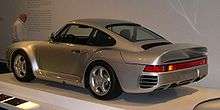Show or Display

The "Show or Display" rule is a statutory amendment to the United States Federal Motor Vehicle Safety Standards (FMVSS) that allows certain privately imported automobiles to be exempted, if the vehicle in question is deemed to meet a standard of "historical or technological significance".
The amendment, which became law on August 13, 1999,[1] is intended to apply to vehicles that could not feasibly be brought into compliance with the FMVSS, including requirements for destructive testing – and that do not have a similar make or model certified for sale in the United States market. Applications are managed by the National Highway Traffic Safety Administration, and may allow limited use on public roads (2,500 miles annually).[2]
Because of the expense and effort required to import a vehicle with this exemption, the approved vehicle list is mainly limited to high-value sports and touring cars.[3]
Detail
The approval for "Show or Display" import is granted if the prospective importer is able to show historical or technological significance of the vehicle in question, and if the vehicle was produced in limited numbers (with 500 being used as a threshold value.) Import approval is granted on a combination of make, model, and production-year; thus, there is no need to re-apply for approved vehicles when further examples are imported in the future. Because the manufacturer of a "Show or Display" vehicle does not necessarily endorse its export to the US, such automobiles may be considered grey market cars.
NHTSA originally proposed an annual mileage limitation of 500 on-road miles, and also required that a certified mileage statement be submitted annually during the first five years after import. During a comment period on the wording of the statute in May 1999, the Special Vehicles Coalition recommended that the figure be increased to 2,500 miles (a figure already in use by the insurance industry as a threshold to describe a limited-use vehicle.) The Coalition also recommended the elimination of the annual mileage statement requirement, as such a statement would not accurately reflect on-road mileage for vehicles that are also used off public roads. Both recommendations were incorporated into the final wording of the statute, though NHTSA retains the right to inspect an imported vehicle for the purpose of verifying mileage.
Citing unspecified concerns about public safety, NHTSA reserves the right to approve a vehicle for "Show or Display" import, but disallow it from being registered for use on public roads. The administration also reserves the right, at the time of import, to place any other arbitrary restrictions or limitations on the use of an imported vehicle. Regardless of "Show or Display" approval, imported vehicles must also meet the import restrictions defined by the Environmental Protection Agency (EPA).
NHTSA does not require FMVSS compliance for any imported vehicles that are above a certain age, currently 25 years.
Notable examples
Microsoft founder Bill Gates bought a Porsche 959 before the model had Department of Transportation and Environmental Protection Agency approval. The car was stored for 13 years by the Customs Service at the Port of San Francisco, until the Show or Display rule came into force.[4][5][1]
References
- 1 2 Display of Speed: Under the "Show or Display exemption, Americans can now import previously forbidden exotics", January 7, 2001, autoweek.com
- ↑ "Federal Register, Vol. 64, No. 134, Rules and Regulations" (PDF). National Highway Traffic Safety Administration. Retrieved 2012-01-16.
- ↑ "Vehicles determined eligible for importation for show or display" (PDF). National Highway Traffic Safety Administration. Retrieved 2012-01-16.
- ↑ Stephan Wilkinson. The Gold-Plated Porsche. The Lyons Press, Guilford, Connecticut (2005) pages 21-2, ISBN 1-59228-792-1.
- ↑ "How To Import A Motor Vehicle For Show Or Display". National Highway Traffic Safety Administration. 2003-07-07.